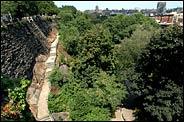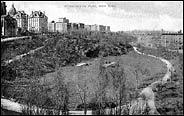
July 31, 2005
Streetscapes Morningside Park
An Oasis of Green, Reclaimed by City and Community
By CHRISTOPHER GRAY
IN the 1960's and 70's, Morningside Park, the effective boundary between Morningside Heights and Harlem, had a dangerous reputation, compounded by years of neglect. But these days, a walk through its craggy slopes, which have gradually been reclaimed by the Parks Department and a community group, can be comfortable and refreshing, with an alpine quality.
After the Civil War, with Central Park almost completed, the Parks Department proposed taking over the narrow, rocky cliffs just east of the barren plateau where Columbia University and other institutions were later to find homes.
The slender area - a picturesque, tumbling rectangle from 110th to 123rd Street, between Morningside Drive and Morningside Avenue - was consonant with the rocky wildness of the north end of Central Park, a block away. And in 1872, The New York Times predicted that what was named Morningside Park "will doubtless be a favorite resort for children and invalids."

Frances Roberts for The New York Times
Morningside Park today
Some of the original plans were drawn up by the designers of Central Park, Frederick Law Olmsted and Calvert Vaux. Others left varying marks, especially the architect Jacob Wrey Mould, who was responsible for the dramatic cliff-top retaining wall, finished in 1895, along the upper edge of the park.

www.metrohistory.com
Morningside Park in 1910 with its dramatic retaining wall
Even before Morningside Park was completed, The Times ran a story about the area's pastoral character. In 1885, the police captured 16 cows illegally grazing on the plantings. Dairymen in the area who were in the habit of pasturing their livestock there were fined $2 a head.
Two years later, a group of Civil War veterans camped in the park for a weekend, fired cannon salutes and, in a mock assault, stormed the castlelike retaining walls. The Times reported that they scrambled up scaling ladders "like cats" even though most "have doubled their waist measure since the days when they did such climbing as a business."
Accounts of crime in Central, Prospect and other parks are frequent in the early 20th century, but Morningside Park seems to have had more than its share. Crime in Morningside Park, because of its proximity to Harlem, was often reported as a racial matter.
The park was seen as extremely dangerous. In 1935, The Times reported that Teachers College of Columbia University had posted a sign in a dormitory informing students "it is not safe to enter Morningside Park at any time of the day or night."
In 1960, Columbia proposed building a huge gym in the park at 113th Street. Opposition to the gym crystalized in major student protests in 1968, and in 1969 the university dropped the project.
Morningside Park's reputation continued in free fall in the 1970's, but in 1981 a group of Columbia undergraduates founded the Friends of Morningside Park, which advocated returning what had been a neglected park to its original design. The group now marshals about 1,000 volunteers, and over two decades it has reclaimed most of what had been a forgotten wilderness. There are few traces of the earlier desolation.
Summer is the most active period: a farmers' market Saturdays from 10 a.m. to 4 p.m. through November in the plaza at 110th Street and Manhattan Avenue; a double Dutch tournament scheduled for Sept. 17; and evening concerts - an eclectic mix, ranging from jazz to West African music (the next is Aug. 13th at 6 p.m.). All events are on the group's Web site, www.morningsidepark.org.
Crime is still around. Jacqueline Connors, treasurer of the group, has lived next to the park since 1976, and says she can recall only one killing there - last December a homeless man was stabbed to death. Brad Taylor, the group's president, notes that robberies may take place outside the park, with the criminals escaping inside. But continued improvements mean that a daytime walk through Morningside Park does not carry the implicit menace it once did.
The rise and fall of the park's north-south paths, weaving in and out between rocky outcrops and lush plantings, are like some of the roller-coaster passages of the Taconic and other motor parkways.
A visitor who arrives without a scaling ladder will want to start from the top, not the bottom, perhaps at the monument to Carl Schurz, at 116th Street and Morningside Drive. The overlook there offers a dramatic sidelong view of the formidable rock face of the mighty retaining wall.
Partway down the hill, birds flutter in a natural bowl of water, fed by an artificial spring. Some of the grounds are woolly and a few inches overgrown, full of crabgrass and dandelions, but others are pristine greenswards.
The p
 lantings grow thicker along the base of the natural rock slope, which tumbles out below the retaining wall down to lush glades, not yet wilted by the summer heat. At the path along the bottom, look for the wildly thorny trunk of a honey locust and the wonderfully swirling roots of an old, ropey oak.
lantings grow thicker along the base of the natural rock slope, which tumbles out below the retaining wall down to lush glades, not yet wilted by the summer heat. At the path along the bottom, look for the wildly thorny trunk of a honey locust and the wonderfully swirling roots of an old, ropey oak.Opposite 114th Street, a bronze statue has a figure of Pan hiding under a rock, menaced by a bear with remarkably detailed paws. The statue does double duty as a drinking fountain.

Most spectacular is a primeval-looking pool nearby, half surrounded by 50-foot-high rock cliffs, with a waterfall gushing down the rock, and the lacy apse of the Cathedral Church of St. John the Divine on Amsterdam Avenue rising above the trees. A daytime stroller counted several score of pedestrians crossing the park, a happy flock of little children skylarking in one of the playgrounds, and perhaps a dozen homeless people asleep on neat bedrolls.

A passing police officer pronounced the safety of the park "decent," although an isolated section at the north end, closed off for reconstruction of a stairway, has been the scene of several recent robberies. Perhaps the problem will diminish when the Parks Department finishes the $995,000 project later this year.
E-mail: streetscapes@nytimes.com



No comments:
Post a Comment